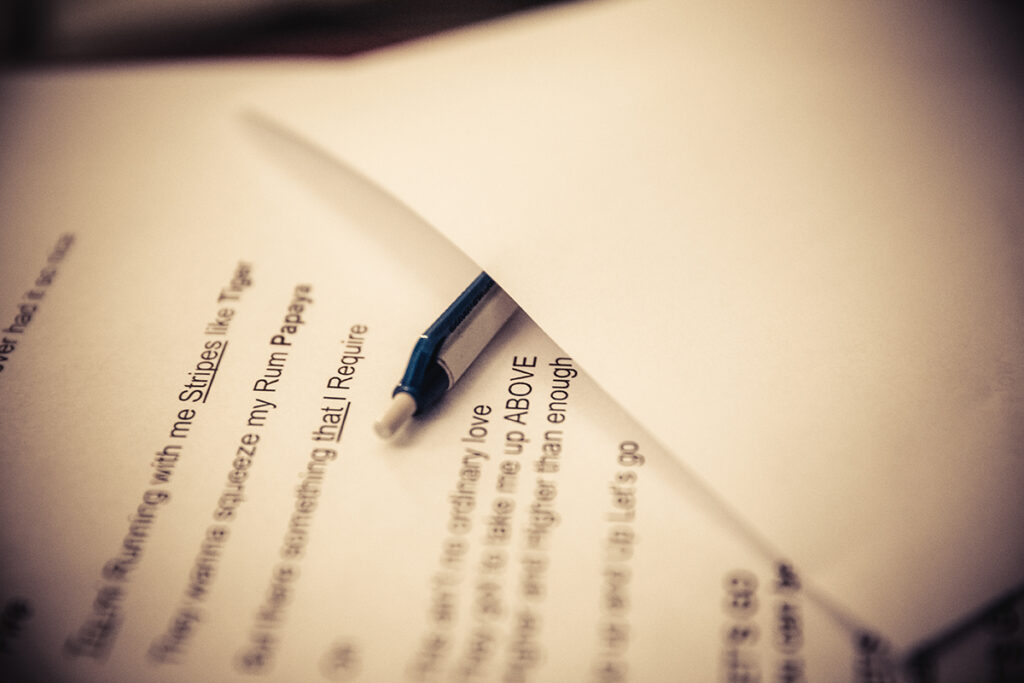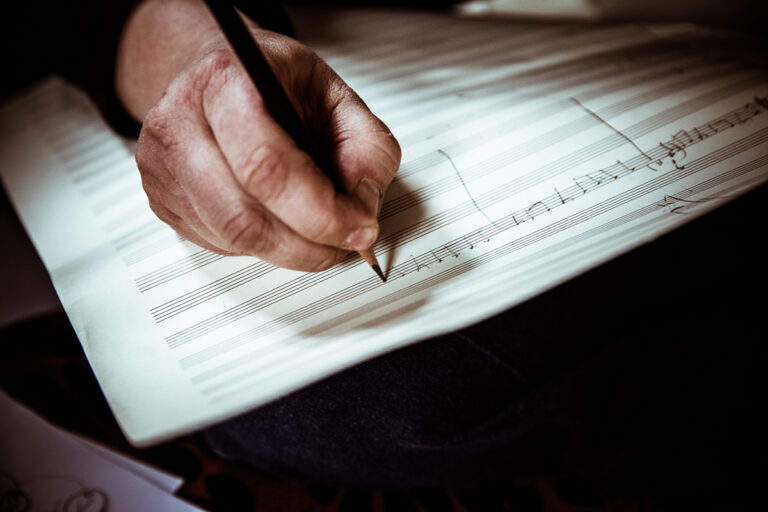As previously underscored in the article “Arranging works protected by copyright”, authors – whether they compose music or write texts – have the right to decide if their work can be arranged; in other words, whether a “derived work” or an “arrangement” can be created from their original work. Texts which are not protected by copyright can be freely used as a basis for a musical work and can also be arranged at will. However, the use or arrangement of texts protected by copyright – i.e. whose authors are still alive or have been dead for less than 70 years – is subject to the rightholders’ consent. The end of the term of protection runs from 31 December of the year the last author alive dies.
Setting poems or parts of texts to music
To set a poem to music, you must first contact the author, their heirs or their publisher and obtain their direct consent to do so. As a rule, the arrangement rights in the case of literary works are held by the publisher; if not, the publisher can at least act as an intermediary. ProLitteris, the Swiss Copyright Society for Literature and the Visual Arts, cannot license these rights.
In the case of elements from a third-party text, the situation is a little trickier. In principle, copyright law does not only protect complete works, it also protects individual parts of a work, provided the term of protection has not expired and the individual parts satisfy the qualifying criteria of a work or impact the individuality of the complete work. Elements of a text (known as “external value”) as well as the plot or characters of a novel (known as “inner value”) can therefore be protected and may not be used at will if in themselves they constitute a work with an individual character or if they impact the individuality of the work as a whole. Copyright law does not only protect entire passages from “The Lord of the Rings”, for example, it also protects Gandalf, the pipe-smoking wizard.
Unfortunately, there is no clear boundary delimiting what parts of a work have individual character or impact an entire work, and what parts do not. The following questions may help you decide: is the excerpt or the inner value in itself so unique that it hardly occurs elsewhere? The length of the excerpt and characteristic elements like names or special word creations can be decisive here. Further: does the excerpt occupy a formative place in the new work?
New settings to music or recording new lyrics
The same applies if you take the lyrics of an existing song and set them to a new melody. This is a new setting to music. In this case, however, you cannot obtain the rights just from the lyricist; you must obtain the rights to the whole musical work from all the original rightholders (i.e. the lyricists and the composers) or from the music publisher. In other words, in the case of jointly created works, consent must be obtained from all the rightholders and not just from the lyricist since you are changing a work that was created to be exploited jointly. Settings to music, on the other hand, are not as a rule regarded as jointly created works. Therefore, each rightholder is free to dispose of their own contribution.
When new lyrics are added to the melody of a song, the legal situation is the same – it is still an arrangement of a musical work. This also applies to the translation of lyrics into another language; even if the contents are identical, a translation is an arrangement requiring consent because it impacts the individuality of the original work.
NB: If you use a translation of a work whose term of protection has expired, you must establish whether the translation is still protected (translations are derived works and as such are also protected by copyright).
Obtaining permission for setting to music or for an arrangement can be an extremely tedious procedure which is not always crowned with success. In any event, you must be sure to allow enough time to clarify the legal status.
| Warning: no silent consent! If a number of requests have been submitted to the rightholder or the (music) publisher and no response has been received, it is wrong to presume that “silence means consent” and that the work can be arranged simply because “efforts were made” to obtain permission. As a rule, arranging a work without the rightholder’s consent constitutes a copyright infringement and may result in civil and criminal prosecution. |
Once you have obtained permission to set to music or undertake an arrangement, you still cannot dispose of the work at will. The permission to set to music, for example, often contains a proviso that the original text must be used faithfully, i.e. that no changes can be made to the original. The permission to arrange may be restricted to a single type of arrangement (e.g. only the translation of the lyrics into another language, or only the use of specific excerpts). Moreover, even after granting permission, authors are entitled by law to defend their work against “distortion”. Such cases (which are hard to judge) constitute an infringement of the author’s “moral rights”.
| A special case: the “sub-lyricist” In sub-publishing agreements, the original publisher sometimes grants the sub-publisher the right to have new language versions of an existing song made. The sub-publisher is thus empowered to commission or authorise translations of the lyrics or new lyrics in another language. In such cases, the lyricist is registered as “sub-lyricist”. SUISA’s Distribution Rules provide that the sub-lyricists’ share may not be higher than provided in the regulatory distribution key. |
Freedom to quote
Is it possible in certain circumstances to “quote” texts without any permission to set to music when creating a musical work? In Switzerland, literary works may be quoted without permission if the quotation serves as an explanation, reference or illustration and provided the source, i.e. the original author, is indicated (see Article 25 FCA). However, case law stipulates that the quotation may not be “purely an end to itself”, in other words the quotation must serve explanatory or information purposes and cannot principally serve to obtain an advantage from the recognition value of the quotation. Whether these conditions can be met in the case of setting to music and publishing is a matter of interpretation, as is often the case, and can only be answered affirmatively with great restraint. In doubt, it is always better to ask the rightholder.
Key points of a permission to set to music
If an author or a publisher grants permission to set a text to music, this permission or consent to set to music should be set forth in a short agreement. The agreement should cover the following points:
- Name and address of the contracting parties (and aliases, if applicable)
- Permission to set to music: the work to be set to music must be named. The agreement must also specify to what extent the text may be edited or arranged. It must define the scope of usage, indicate if printing rights are included and, in case the setting to music is published, whether the author of the text must be designated, and how. The agreement must also indicate whether and how the new work is to be registered with SUISA. Setting-to-music agreements are generally non-exclusive. The composers do not derive any rights to the text from such agreements. These rights remain entirely with the author of the text.
- Share of the author of the text: SUISA’s Distribution Rules grant equal shares to the composer of the music and the lyricist or author of the text. In the case of unpublished works, the share is 50% each; for published works, the share is 33.33%. As a rule, however, the shares may be set at the parties’ discretion. Book publishers do not often participate in the exploitation rights of the sound recording unless they are members of a copyright collecting society for music and the permission for setting to music provides for such participation.
The original rightholders often demand a flat-rate fee for the setting to music, and in certain cases the publisher also demands a percentage share on the sale of sheet music if the graphic rights are transferred. - Publishing of the setting to music: the text share of the setting to music is not automatically transferred to the music publisher. The publisher must conclude a separate publishing agreement with the author of the text in respect of this share. The publishing rights of major authors are often already held by a book publisher and cannot be transferred to the music publisher.
- Warranties: the rightholders must warrant that they dispose of the rights to grant the arrangement rights.
- Place, date and signature of the rightholders
- Governing law and jurisdiction
How to register a setting to music with SUISA
To register the setting to music of a protected text, you must provide the permission to set to music. If no specific percentage shares were agreed, SUISA’s Distribution Rules will apply. If the author of the text is not member of a music collecting society and does not wish to join one, SUISA will accept transfers to the composers. In this case, the composer and the author of the text will both appear in the database as authors, but both shares will be paid to the composer. The corresponding consent from the author of the text is mandatory.
Summary
As a rule, to set a poem to music you always need permission from the rightholder(s) – depending on the circumstances, this permission can be obtained from the authors, their heirs or the relevant publisher. The permission for setting to music is a prerequisite for registering a protected text with SUISA and is the legal basis for participation in the revenues from the work.
As a rule, for a setting to music, you need to contact the book publisher. For texts which have not been published, ProLitteris can help you identify the relevant rightholders. SUISA can only help if the author is one of its members. In such cases, SUISA will pass on requests for setting to music to the authors or their heirs. Requests should be sent to: authors (at) suisa (dot) ch





Guten Tag Frau Leuenberger
ich habe vor einiger Zeit eine CD aufgenommen mit dem Name (Drei rote Rosen Nr. 577) worauf sich die Songs Immer nur du und Mondscheinnacht befinden. Jetzt habe ich festgestellt dass andere Musiker diese Stücke auf einer CD veröffentlicht haben. Wäre da nicht eine Gutschrift fällig.
Danke für eine Antwort.
mfg E. Rick Sommer
Sehr geehrter Herr Sommer
Vielen Dank für Ihren Kommentar. Zur Beantwortung Ihrer konkreten Anfrage besteht weiterer Abklärungsbedarf. Bei spezifischen Einzelfällen wie diesem empfehlen wir deshalb, direkt den Rechtsdienst der SUISA zu kontaktieren: legalservices (at) suisa (dot) ch
Freundliche Grüsse
Manu Leuenberger / SUISA Kommunikation